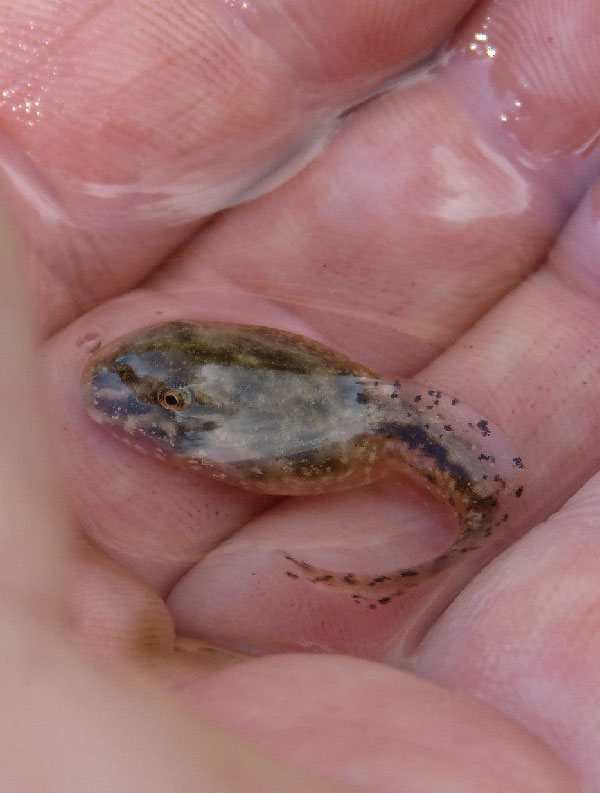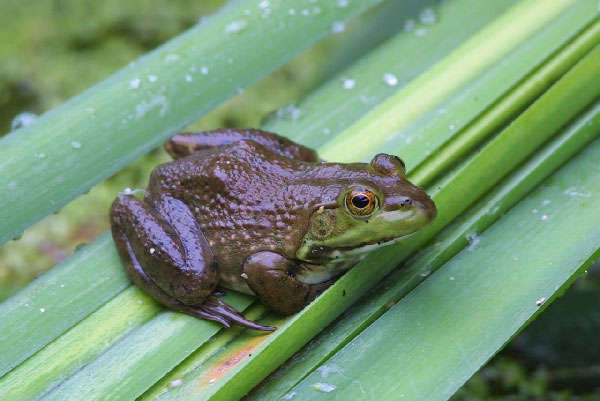Their Introduction
The North American Bullfrog, Lithobates catesbeianus, is indigenous and native to the Eastern U.S. but in the late 1800s and very early 1900's it was introduced into areas to the west. It is thought that originally a few groups of bullfrogs were brought to the extreme southeastern corner of Nebraska by early French fur traders as food stock and the frog became established.
Later (1900 -1940) bullfrogs were introduced across the entire state and the western US with fish stocking and for frog farming for food. Bullfrogs are not a native/natural component part of these ecosystems and have no natural predators to keep them in check. In these locations, bullfrogs have acquired a reputation as a major predator on native vertebrates, including some endangered species. They have been known to take young waterfowl and cause the decline and disappearance of native frogs.
Identification
It is the largest frog in Nebraska and has become the most common. Bullfrogs are found in many aquatic habitats statewide. Its color is variable, with darker shades of green and greenish brown common. The underside or belly is white or while marbled with dark gray. Their eyes are gold or brown and they have a broad flat head and body. Their eardrums (tympanum) are prominent and as large or larger than their eyes. The bullfrog's body length can easily exceed 6 - 8 inches (15 -20 cm).
Bullfrogs are opportunistic and voracious predators, feeding on small snakes, birds, other frogs, mice and even smaller birds and waterfowl. Apparently they will gobble up anything that moves and can be forced into their big mouth.
 Bullfrog tadpoles can be identified by the tiny black dots on their bodies and tails.
Bullfrog tadpoles can be identified by the tiny black dots on their bodies and tails. Life Cycle
Bullfrogs are prolific breeders in permanent bodies of water. This is different from any of Nebraska's native frogs that breed in fishless temporary waters. The call of male frogs, "jug-o-rum," is heard most often from late June through August in Nebraska.
Bullfrog females lay more than 20,000 eggs at a time. In contrast to many other frogs, the tadpoles of bullfrogs are typically resistant to predation by most fish, so that large numbers of juveniles are produced successfully from a single mating.
Bullfrog tadpoles are apparently toxic or distasteful to fish and some other predators. The tadpoles may grow to nearly 6 inches in length and usually take at least a year - sometimes two - to transform.
Larger tadpoles are easily identified by the presence of tiny, distinct black dots scattered on their bodies and tails. Juvenile bullfrogs often disperse into small pools, ditches, or other bodies of water to live and grow until they reach adult size before moving back to more permanent bodies of water where they can establish territories. Startled young adult individuals may also voice a shrieking "alarm call" as they leap into the water.
Adult bullfrogs have smaller territories compared to most other frogs and therefore are the most likely species you will have in an acreage or landscape pond. They will move during raining evenings. Bullfrogs overwinter in the mud at the bottom of ponds.
Control & Harvesting
Bullfrogs are the only game species of amphibian in the state. There is a season and harvest limit on adults captured for food.
Heavy trapping of adults and collection of their egg masses may eliminate or reduce bullfrog populations, but this can be quite time-consuming and expensive. If any manage to escape, they can quickly replace their numbers to what they were before these activities took place.
Prevention is probably the best and most effective measure to combat the expansion of bullfrogs into the native environment. That means don't bring bullfrogs to your pond.
For more information on the North American bullfrog and other amphibians, including call recordings, visit Amphibians, Turtles and Reptiles of Nebraska, from the UNL School of Natural Resources.

